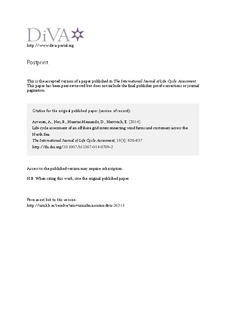| dc.description.abstract | Purpose: This study aims to contribute to an improved understanding of the environmental implications of offshore power grid and wind power development pathways. To achieve this aim, we present two assessments. First, we investigate the impacts of a North Sea power grid enabling enhanced trade and integration of offshore wind power. Second, we assess the benefit of the North Sea grid and wind power through a comparison of scenarios for power generation in affected countries.
Methods: The grid scenario explored in the first assessment is the most ambitious scenario of the Windspeed project, and is the result of cost minimization analysis using a transmission expansion planning model. We develop a hybrid life cycle inventory for array cables, HVDC links and substations. The functional unit is 1 kWh of electricity transmitted. The second assessment compares two different energy scenarios of Windspeed for the North Sea and surrounding countries. Here we utilize life cycle inventory for offshore grid components together with inventory for a catalog of power generation technologies from Ecoinvent, and couple these inventories with grid configurations and electricity mixes determined by the optimization procedure in Windspeed.
Results and discussion: Developing, operating and dismantling the grid cause emissions of 2.5 g CO2-Eq per kWh electricity transmission, or 36 Mt CO2-Eq in total. HVDC cables are the major cause of environmental damage, causing for example half of total climate change effects. The next most important contributors are substations and array cabling used in offshore wind parks. Toxicity and eutrophication effects stem largely from leakages from disposed copper and iron mine tailings and overburden. Results from the comparison of two scenarios demonstrate a substantial environmental benefit from North Sea grid extension and the associated wind power development compared to an alternative generation of electricity from fossil fuels. Offshore grid and wind power, however, entail an increased use of metals and hence a higher metal depletion indicator.
Conclusions: We present the first life cycle assessment of a large offshore power grid, using results of an energy planning model as input. HVDC links are the major cause of environmental damage. There are differences across impact categories with respect to which components or types of activities that are responsible for damage. North Sea grid and wind power are environmentally beneficial by an array of criteria if displacing fossil fuels, but cause substantial metal use.
| nb_NO |
